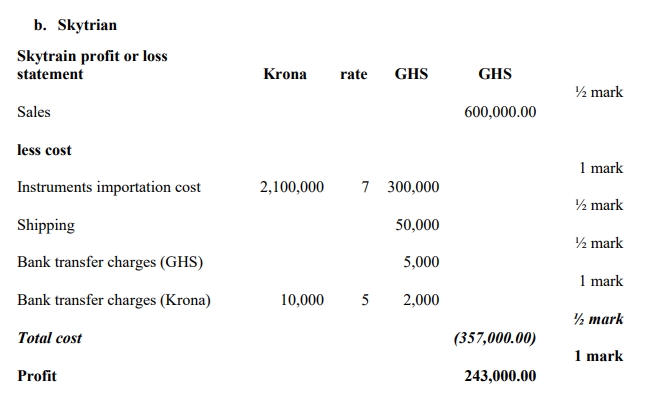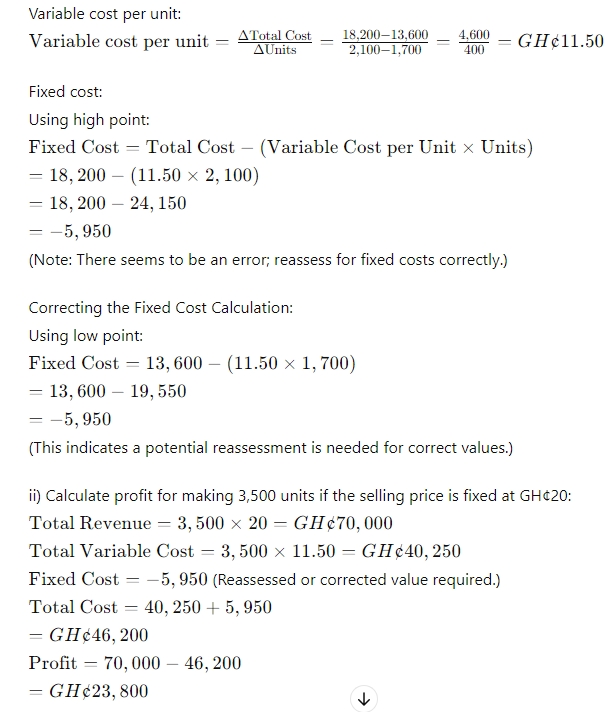(i) Based on the value of work certified, the contract is 64% complete ((320 / 500) x 100) at 30 September 2012. Extracts for 2012 are:
LB LTD
STATEMENT OF PROFIT OR LOSS (EXTRACTS) FOR THE YEAR ENDED 30TH SEPTEMBER 2012
| Description |
GH¢ million |
| Revenue ((500 x 64%) – 200) |
120 |
| Cost of sales ((400 x 64%) – 160) |
(96) |
| Profit ((100 x 64%) – 40) |
24 |
LB LTD
STATEMENT OF FINANCIAL POSITION (EXTRACTS) AS AT 30TH SEPTEMBER 2012
| Description |
GH¢ million |
| Current assets |
|
| Amounts due from customers |
|
| – Contract costs to date |
290 |
| – Profit recognized (100 x 64%) |
64 |
| Total assets |
354 |
| Progress billings |
(320) |
| Net assets |
34 |
| Contract receivables (320 – 300) |
20 |
(ii)
Accounting policies are the rules, principles, and practices adopted by an entity in preparing its financial statements. They should be based upon IFRSs or other financial reporting standards.
Accounting estimates are the measurements and valuations arrived at by an entity in applying accounting policies to specific items and transactions.
In the case of LB Ltd, the accounting policy is in accordance with IAS 11 Construction Contracts. Revenue and costs are recognized according to the stage of completion of the contract. LB’s current means of estimating the stage of completion is based on the proportion of cost to date to total cost.
Although the question refers to it as LB’s ‘current policy,’ this is an accounting estimate, because it is LB’s method of applying the accounting policy. A different measurement basis, based on the same accounting policy, is to estimate stage of completion based on the value of work certified. In transferring from one to the other, LB is making a change of accounting estimate.
c)
If a branch is accounted for through the head office, tight control can be maintained. Inventory is normally transferred to the branch at selling price, and the following accounts are maintained in the head office ledger:
- Branch inventory control account – goods transferred recorded at selling price.
- Branch mark-up account.
- Goods sent to branch account – goods transferred recorded at cost price.
The branch inventory account will be debited when goods are sent to the branch and credited when they are sold. At the end of the period, after adjusting for unsold inventory, the mark-up account will show the gross profit of the branch.
Under this system, branch expenses are usually paid centrally from the head office.
A branch which is set up as a separate entity will keep its own full accounting records and pay its own expenses. Initial assets will be transferred to the branch from head office, and transactions between the branch and the head office will go through a branch current account in the head office ledger, representing net investment in the branch, and a head office current account in the branch ledger, representing the capital provided by head office. At the end of the period, these two accounts will be reconciled.
Goods will be transferred to the branch at cost or at a small mark-up, so that the branch can add its own mark-up. At the end of the period, adjustments will have to be made for any goods or cash in transit and for any unrealized profit in inventory, where goods have been transferred to the branch at an amount above cost price.


